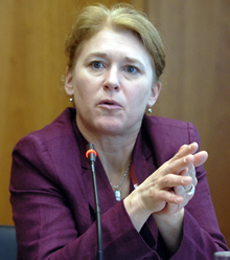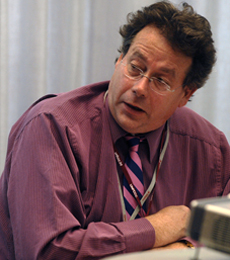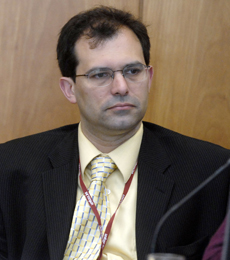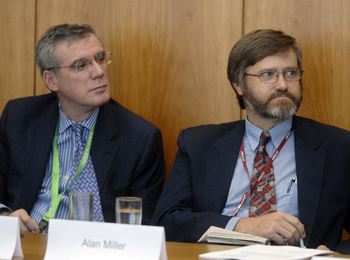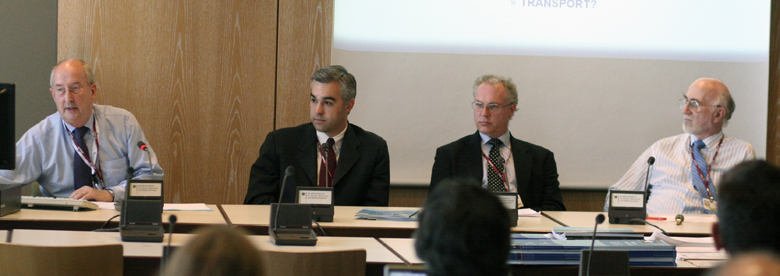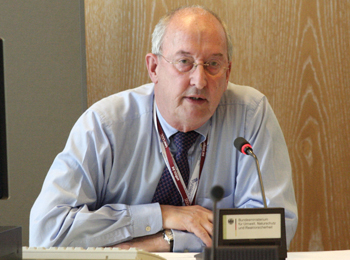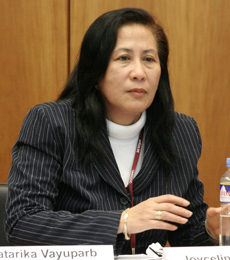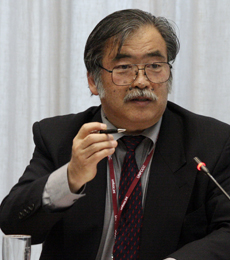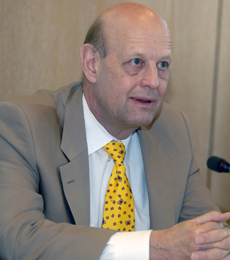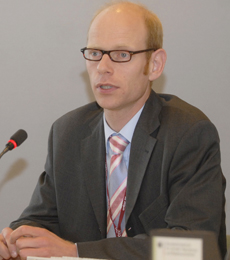 |
||
|
Published by the International Institute for Sustainable Development (IISD)
|
|||
|
A Special Report on Selected Side Events at the twenty-sixth sessions of the Subsidiary Bodies (SB 26) of the United Nations Framework Convention on Climate Change (UNFCCC)
|
|||||
| 7-18 May 2007 | Bonn, Germany | |||||
 |
|||
 |
|||
Events convened on Wednesday, 16 May 2007
|
Market mechanisms for sustainable development: Presented by the International Institute for Sustainable Development (IISD) |
|||
|
John Drexhage, IISD, introduced IISD’s study on Market Mechanisms for Sustainable Development (MMSD).
Deborah Murphy, IISD, presented the study, noting developed and developing countries’ differing interests in MMSD. She highlighted the different implications of various post-2012 approaches, and said important post-2012 regime characteristics to consider include: targets; differentiation; transition; and the development dividend. Brent Swallow, World Agroforestry Centre, discussed, inter alia, the potential for market-based mechanisms to avoid deforestation and the opportunity costs of different REDD policy instruments. Rob Bradley, World Resources Institute, emphasized that market mechanisms have been called on to deliver on a wide range of goals. Noting that they can be powerful tools in the right conditions, he said they are less compelling in wider sustainable development and interstate financial transfers. Emphasizing the need for realistic expectations of market mechanisms, he called for the nurturing of credible and robust supply. Andrei Marcu, International Emissions Trading Association, said that markets would not deliver when optimizing on unclear objectives, or on measures that are difficult to quantify. Noting the difficulty of measuring sustainable development benefits and of verifiable emissions reductions, he reiterated the need to drive demand. Alan Miller, International Finance Corporation, emphasized the need to consider the larger political dynamic. He suggested: the carbon market will do more for development the more it becomes a high-volume accepted commodity routinely incorporated in international finance; the carbon market may have been “oversold;” and the creation of higher-value specialized products may hold great potential. Agus Sari, Ecosecurities Indonesia, discussed the current CDM’s shortcomings including its bureaucracy, lack of transparency, and project distribution. He questioned whether: a single carbon market or a spot market will develop; credits are fungible; or credits will flood the market. |
|||
|
|||
|
Electric technologies in a carbon constrained world Presented by EURELECTRIC, EPRI, EEI |
|||
|
Bill Kyte, e•on UK, emphasized the need for certainty and said electricity has the potential to be carbon free by 2050.
Bryan Hannegan, Electric Power Research Institute (EPRI), US, discussed the electricity sector technology needs for a carbon constrained world. He highlighted the current lack of technological capabilities to meet new demand in a low-cost and low-carbon way and called for R&D, particularly on the grid infrastructure, nuclear energy and spent fuel, and commercial-scale carbon capture storage (CCS). He emphasized the technical feasibility of significant GHG emission reductions by 2030 given aggressive action, but said that a mix of technologies, rather than a single “silver bullet” technology, was needed. John Scowcroft, EURELECTRIC, noted the changing policy landscape, and said the key drivers for the electric sector - security of supply, competitiveness and climate change - suggest that business-as-usual is unsustainable. He emphasized the need to unleash demand-side efficiency and discussed the development of heat pumps as a substitute for fossil fuels in the residential sector. On the supply-side, he discussed the role of CCS, renewables and nuclear energy. He outlined the modeling effort undertaken, which demonstrated, given the deployment of demand- and supply-side technologies, over a 30% of carbon dioxide emissions reduction in the sector, and roughly the same total cost of energy compared to business-as-usual. He discussed the implied power mix in Europe, noting the expansion of nuclear energy, and said technologies are the key to cost-effectiveness. Eric Holdsworth, Edison Electric Institute (EEI), US, presented the US electric utility perspective and challenges, including a projected 40% demand growth by 2030. He said there are no realistic short-term options to significantly reduce GHG emissions, given that clean coal technologies, CCS technologies, and deployment of nuclear plants are not commercially or politically viable for one to two decades. He called for a near-term focus on: renewables and energy efficiency; cleaner coal, nuclear, and gas generation technologies; and deployment of CCS and nuclear technologies, to buy time for next generation technologies. He discussed Congressional and other factors affecting the U.S. political context. Holdsworth outlined the EEI Global Climate Change Principles, including the need to retain industry competitiveness and ensure an economy-wide approach. He noted the Asia-Pacific Partnership as an exciting development and highlighted the need for R&D investment and utilization of all technologies and fuels. Participants discussed sectoral approaches, the electricity sector’s linkages with other sectors, the potential for interstate collaboration, CCS, and wind energy. |
|||
|
|||
|
Lessons learned from CDM capacity building: Is there a need to reform international and domestic rules? Presented by the Institute for Global Environmental Strategies (IGES) |
|||
|
Taka Hiraishi, IGES, noted the limits of CDM, and said the side event would explore the lessons learned and obstacles faced regarding CDM implementation in a number of Asian countries.
Kazuhisa Koakutsu, IGES, highlighted that the IGES CDM capacity building programme aims to increase institutional and operational CDM capacity in Asian countries. He summarized IGES activities that include assistance to designated national authorities (DNAs) and project development. Koakutsu underscored the programme’s outputs, such as: the “CDM/JI in Charts” publication; a technical report; and successful CDM implementation using Japanese government credit transfer mechanisms, such as an upfront payment scheme and the Credit Acquisition Program. Yuji Mizuno, IGES, questioned whether there is a need to reform CDM international and domestic rules. He noted shortcomings related to CDM implementation, such as that the majority of CERs come from non-carbon dioxide reduction projects, and the non-equitable regional distribution. Mizuno underscored that CDM projects are not substantially promoting technology transfer, nor alleviating poverty. He said that, before a CDM project is implemented, DOEs need to check the additionality criterion and emission reductions calculation, while DNAs must check the sustainable development contribution. Joyceline Goco, Department of Environment and Natural Resources, Philippines, noted the importance of: capacity building efforts before establishing DNAs; the approval procedure for CDM; and stakeholder consultations. She noted barriers in the approval procedure, including: delays in processing applications; incomplete submissions; limited number of local CDM advisors; and lack of local DOEs. Natarika Vayuparb Cooper, Office of the Natural Resources and Environmental Policy and Planning, Thailand, noted the Thai government’s decision to revise the sustainable development criteria for CDM projects. She outlined the results of the review and outlined the elements of the criteria, which currently include environmental, natural resources, social, economic and technological improvements. She noted barriers faced in the CDM approval procedure, including: a lengthy process that requires the Cabinet’s approval; diverse levels of public awareness regarding CDM; and the limited capacity of government staff to deal with CDM-related issues. Haneda Sri Mulyanto, Ministry of the Environment, Indonesia, underscored the long national process toward the ratification of the Kyoto Protocol, and said that the DNA approval procedure includes the need for developers to make a complete submission, and show a contribution to national sustainable development. He outlined barriers in the CDM approval procedure, such as: availability of data for baseline calculations; lack of flexibility on methodologies; and uncertainties about post-Kyoto commitments. Fei Teng, Tsinghua University, China, noted that the Chinese DNA’s activities involve accepting CDM project applications, handling approval procedures, and establishing CDM-specific institutions. He said that China defines priority areas for CDM projects, including projects that clearly meet sustainable development criteria, such as energy improvement, and utilization of new and renewable energy. |
|||
|
|||
|
BASIC Project: São Paulo Proposal for an agreement on the future Presented by the Institute of Development Studies, University of Sussex |
|||
|
Niklas Höhne, Ecofys, noted the Basic Project aims to build and strengthen institutional capacities in climate change, and explained that the São Paulo Proposal (SPP) addresses the issue of future international climate policy and negotiations. He noted that the SPP is not a consensus document and does not reflect the views of BASIC Project governments. He explained the implications of the SPP on global emissions. Höhne summarized the benefits for both Annex I and non-Annex I parties under the SPP.
Erik Haites, Margaree Consultants, said the SPP aims to create a comprehensive, stable, long-term and universal regime to deal with climate change. He explained that the SPP: promotes the Convention’s principle of common but differentiated responsibilities; establishes a stable, long-term regime for technological and structural change; and has flexibility to cope with changing circumstances. He said the SPP suggests keeping the legal structure of the Kyoto Protocol, with Annex I parties’ quantified emission targets, which could expand to net LULUCF emissions. Haites noted that the SPP suggests known annual commitments for the next five years, with a zero to 5% reduction for the subsequent five years. He said that in the case of economic hardship of an Annex I party whose real GDP has declined by more than 1% during a year, the party may request that its target be equal to its emissions for that year. He underscored that the SPP favors continuing with CDM projects for Non-Annex I parties, with a 2% levy on JI applying only to international emissions trading, and the funds going to a Technology Fund. Haites noted that the SPP advocates establishing voluntary commitments for promoting sustainable development policy and measures, and embracing emissions reduction commitments at a later stage. He noted that the SPP has an adaptation proposal, in which all parties revise design parameters and standards for infrastructure and equipment to address, e.g., energy and water efficiency. |
|||
|
|
|||
|
||
|
Click the above button to go back to our ENB main coverage
|
||
|
|
|
|
|
||
|

